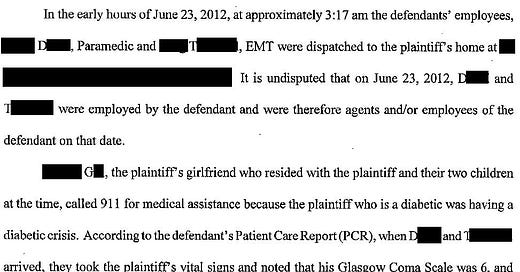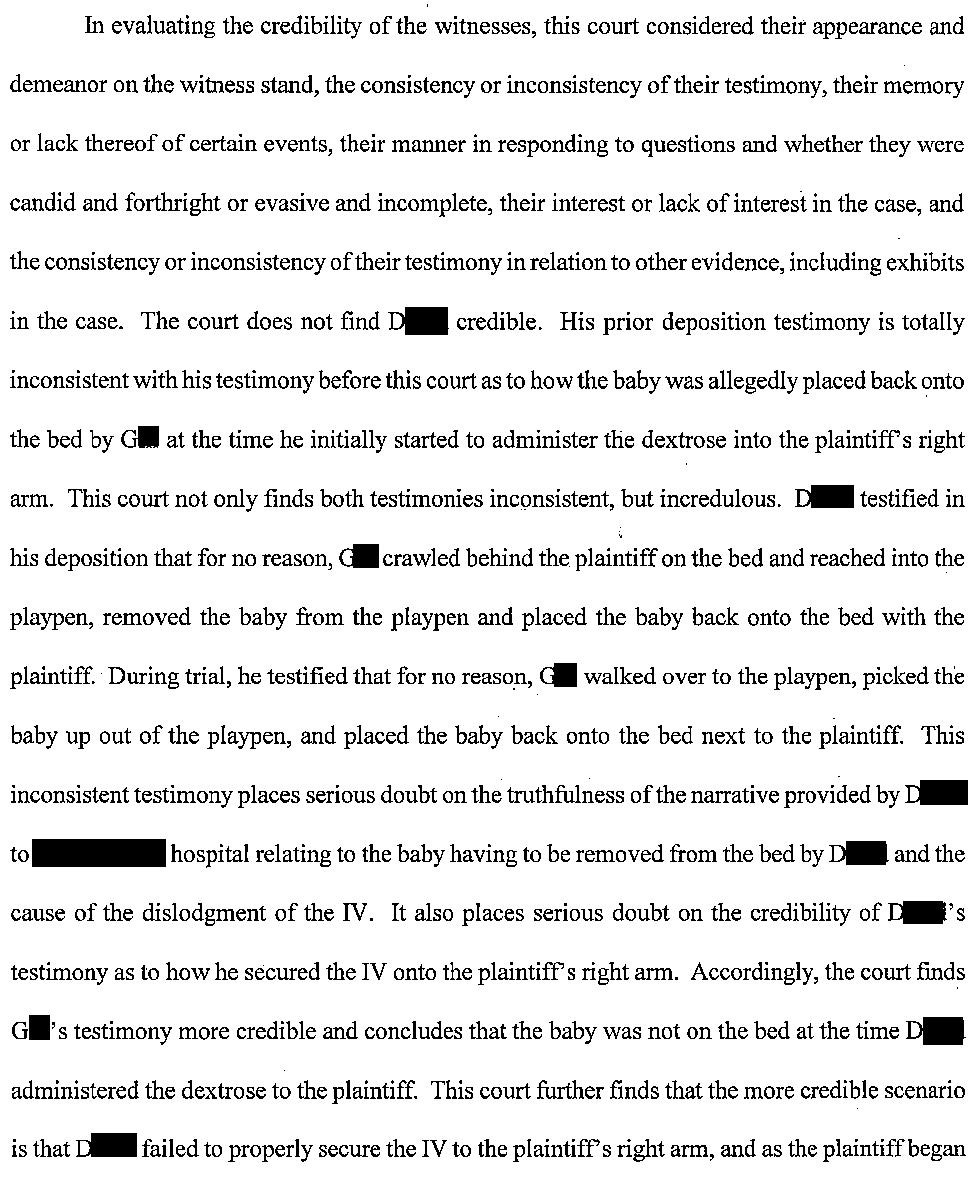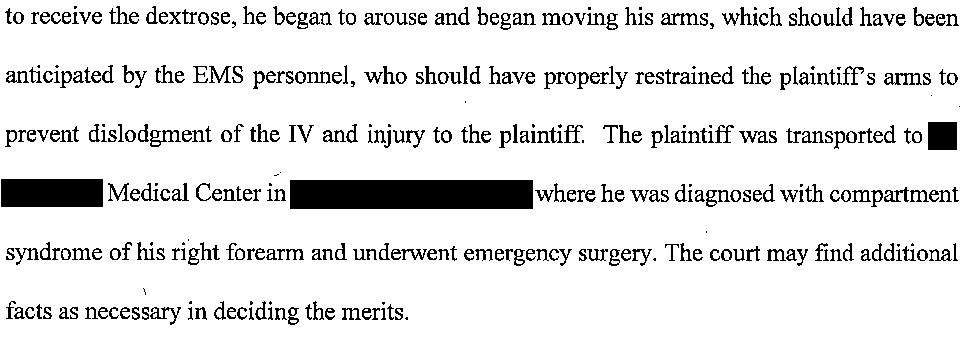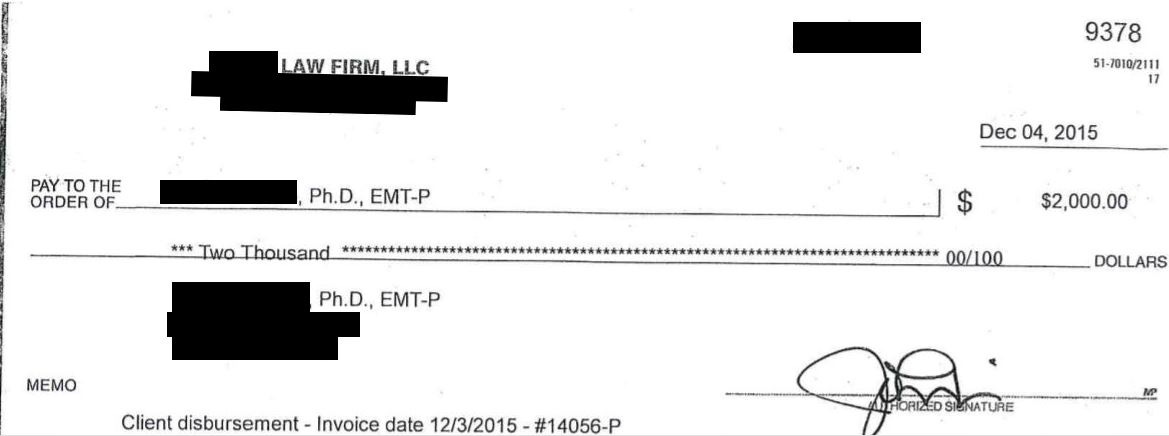The lawsuit was decided by directed verdict, in which the judge unilaterally decides the case because no reasonable jury could reach a different conclusion.
The judge’s summary of the facts and his opinion about the case are show below.
The characters in the case are identified by first letter of their last name:
Mr. D - paramedic
Mr. T - EMT
Mr. B - patient
Ms. G - patient’s girlfriend
L - patient and girlfriend’s 7-month-old child
The judgment is shown below:
The defense appealed.
Before the case was tried in appellate court, the two sides reached a confidential settlement.
The plaintiff disclosed their expenses in bringing this lawsuit.
These records depict the process of the plaintiff’s attorney hiring the EMS expert, and his subsequent fees and billing records.
The plaintiff’s attorney and EMS expert had an initial phone call, followed by this email from the attorney:
The expert’s response included disclosure of his hourly rate of $250/hr.
Later in the case he was deposed by the defense, charging $2000 due to the fact that he took the entire day off work.
As is the case with most expert witnesses, there is an hourly rate for record review ($250/hr), and a specific sum per day ($2000/day) for deposition or trial testimony.
Annual subscriptions are temporarily discounted to only $144.
The plaintiff’s attorney had no problem paying the expert for his work.
However, the defense objected to paying $2000 for a deposition that only took a few hours.
They notified the plaintiff’s attorney of this ahead of time:
The defense intended to pay him his hourly rate instead of the $2000.
They also did not want to pay his full hourly rate for travel to and from the deposition, intending only to pay him a reduced travel rate.
At the end of the deposition, the defense attorney made sure to note their ending time, as well as asked him about his commute home.
The defense attorney was very sly and essentially laid a clever trap for the expert witness.
The witness thought he was engaging in post-deposition pleasantries, but really the defense attorney was collecting further proof for his attempt to pay him a truncated fee.
Furthermore, the witness also accidentally admitted that he was going the “scenic way” home, implying that there was a more efficient route.
Not only did he fall into the trap, he made an unforced error.
Months later, the defense attorney filed a motion, requesting that the judge reduce the expert’s payment.
Ultimately this was a moot point.
The plaintiff’s attorney collected a large cut of the settlement and used part of it to pay the expert for his work.
The $2000 check for the deposition is shown here:
MedMalReviewer Analysis:
If you’re working as an expert witness, be careful about what you tell the opposing counsel that is not directly related to the case. This expert ended up being paid for his work, but there are periodic examples in which a judge reduces the amount that a doctor is paid.
If you are hired by a plaintiff’s attorney, it is wise to collect an initial deposit early in the course of your relationship with them. They are fronting the costs of litigation with no guarantee that they will recover anything. There are plenty of examples of unscrupulous plaintiff’s attorneys who disappear or stop responding once they realize they don’t have a good case, leaving expert witnesses unpaid.
If you are hired by a defense attorney, most expert witnesses simply send periodic invoices as they work on the case, rather than collect an initial deposit. The defense attorneys usually work for large professional liability insurers, which all but guarantees the expert will get paid.There are 2 competing theories:
The IV was never in the patient’s vein, or rapidly slipped out of the vein because it was not secured properly. Half an amp of D50 (25mL) was pushed directly into the soft tissue of the forearm. This could cause immense pain, which would explain why the patient started to flail around. The baby had nothing to do with it but turned into a convenient scape goat.
The IV was placed appropriately. The initial push of D50 is given intravenously, and raises the blood glucose enough to awaken the patient. He begins to flail. The paramedic scrambles to “save the baby”, and in the process the IV dislodges and only then does part of the D50 enter the forearm. In this version, less of the liability falls on the EMS crew because if the girlfriend had not put the baby on the bed, they could have focused their attention on the IV and prevented disaster.
Overall I agree with the judge’s opinion. The EMS crew seems to be looking for an excuse and finds it in the baby. The rapid and wild response from the patient seems more consistent with pain than emergence from hypoglycemia.
Feedback from a reader:
“If you are thinking about doing expert witness work, I would highly recommend paying for MedMalReviewer's subscription service. That site has tons of examples of expert witness testimony and it cites the fees charged by physician expert witnesses of various specialties. Generally a more experienced expert witness can command a higher fee. There are usually multiple listed fees, for chart review, time spent in court / deposition, etc.”
















